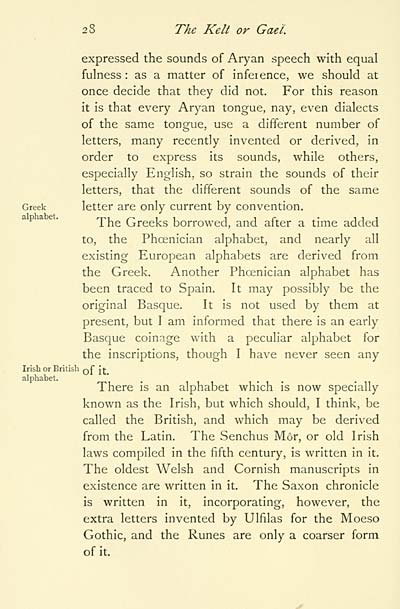Blair Collection > Kelt or Gael
(32)
Download files
Complete book:
Individual page:
Thumbnail gallery: Grid view | List view

28 The Kelt or Gael.
expressed the sounds of Aryan speech with equal
fulness: as a matter of infeience, we should at
once decide that they did not. For this reason
it is that every Aryan tongue, nay, even dialects
of the same tono^ue, use a different number of
letters, many recently invented or derived, in
order to express its sounds, while others,
especially English, so strain the sounds of their
letters, that the different sounds of the same
Greek letter are only current by convention.
^ ^ ^ ^ ■ The Greeks borrowed, and after a time added
to, the Phoenician alphabet, and nearly all
existing European alphabets are derived from
the Greek. Another Phoenician alphabet has
been traced to Spain. It may possibly be the
original Basque. It is not used by them at
present, but I am informed that there is an early
Basque coinage with a peculiar alphabet for
the inscriptions, though I have never seen any
Irish or British of it
alphabet.
There is an alphabet which is now specially
known as the Irish, but which should, I think, be
called the British, and which may be derived
from the Latin. The Senchus Mor, or old Irish
laws compiled in the fifth century, is written in it.
The oldest Welsh and Cornish manuscripts in
existence are written in it. The Saxon chronicle
is written in it, incorporating, however, the
extra letters invented by Ulfilas for the Moeso
Gothic, and the Runes are only a coarser form
of it.
expressed the sounds of Aryan speech with equal
fulness: as a matter of infeience, we should at
once decide that they did not. For this reason
it is that every Aryan tongue, nay, even dialects
of the same tono^ue, use a different number of
letters, many recently invented or derived, in
order to express its sounds, while others,
especially English, so strain the sounds of their
letters, that the different sounds of the same
Greek letter are only current by convention.
^ ^ ^ ^ ■ The Greeks borrowed, and after a time added
to, the Phoenician alphabet, and nearly all
existing European alphabets are derived from
the Greek. Another Phoenician alphabet has
been traced to Spain. It may possibly be the
original Basque. It is not used by them at
present, but I am informed that there is an early
Basque coinage with a peculiar alphabet for
the inscriptions, though I have never seen any
Irish or British of it
alphabet.
There is an alphabet which is now specially
known as the Irish, but which should, I think, be
called the British, and which may be derived
from the Latin. The Senchus Mor, or old Irish
laws compiled in the fifth century, is written in it.
The oldest Welsh and Cornish manuscripts in
existence are written in it. The Saxon chronicle
is written in it, incorporating, however, the
extra letters invented by Ulfilas for the Moeso
Gothic, and the Runes are only a coarser form
of it.
Set display mode to: Large image | Transcription
Images and transcriptions on this page, including medium image downloads, may be used under the Creative Commons Attribution 4.0 International Licence unless otherwise stated. ![]()
| Early Gaelic Book Collections > Blair Collection > Kelt or Gael > (32) |
|---|
| Permanent URL | https://digital.nls.uk/75787036 |
|---|
| Description | His ethnography, geography and philology. |
|---|---|
| Shelfmark | Blair.17 |
| Additional NLS resources: | |
| Attribution and copyright: |
|
| Description | A selection of books from a collection of more than 500 titles, mostly on religious and literary topics. Also includes some material dealing with other Celtic languages and societies. Collection created towards the end of the 19th century by Lady Evelyn Stewart Murray. |
|---|
| Description | Selected items from five 'Special and Named Printed Collections'. Includes books in Gaelic and other Celtic languages, works about the Gaels, their languages, literature, culture and history. |
|---|

